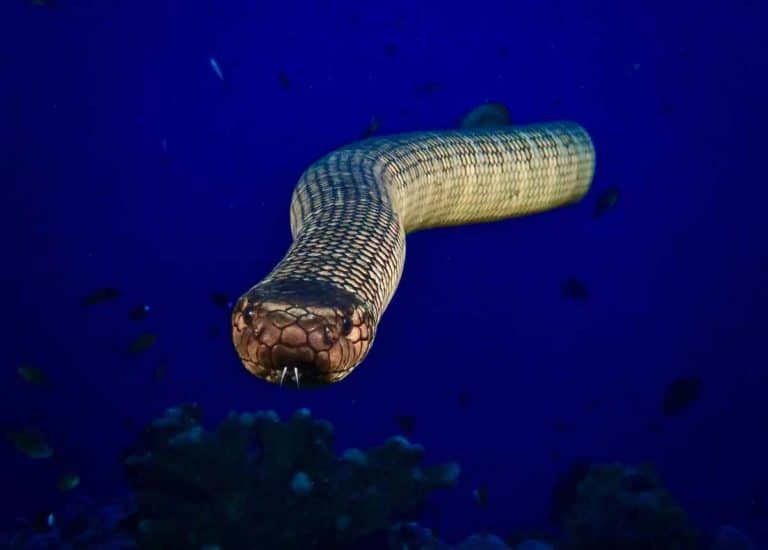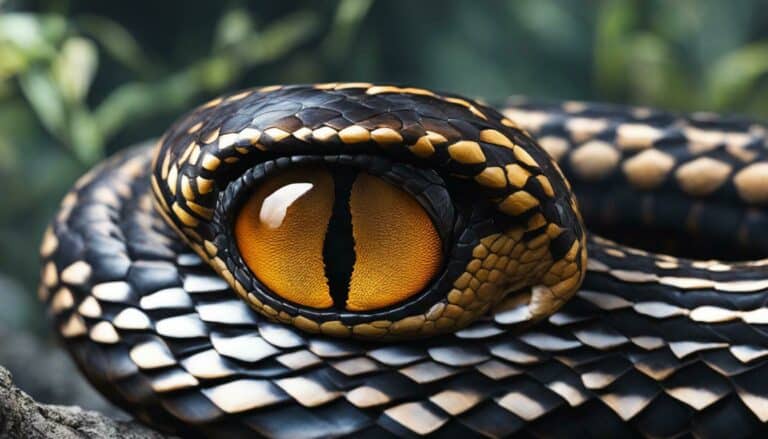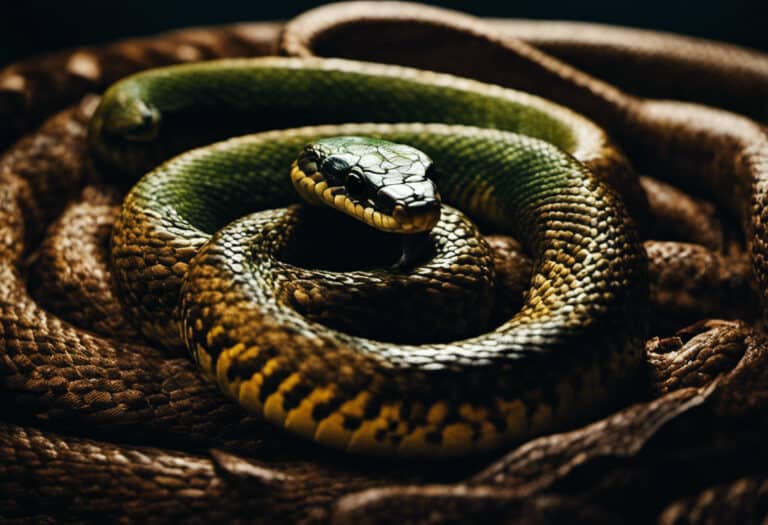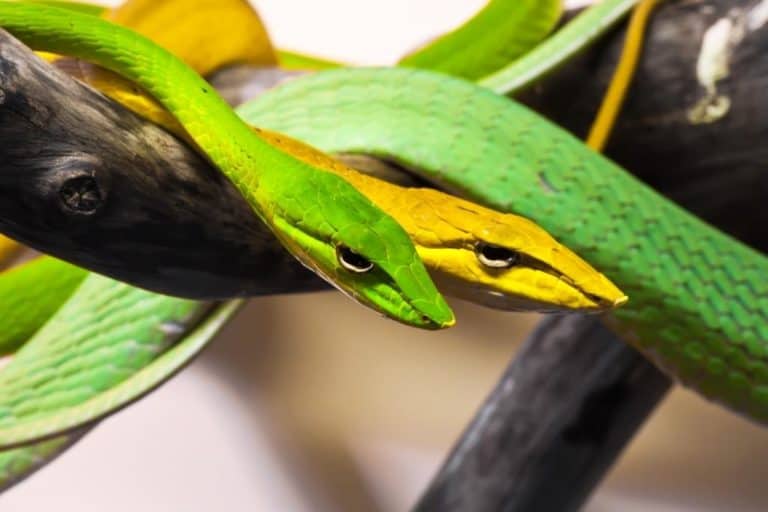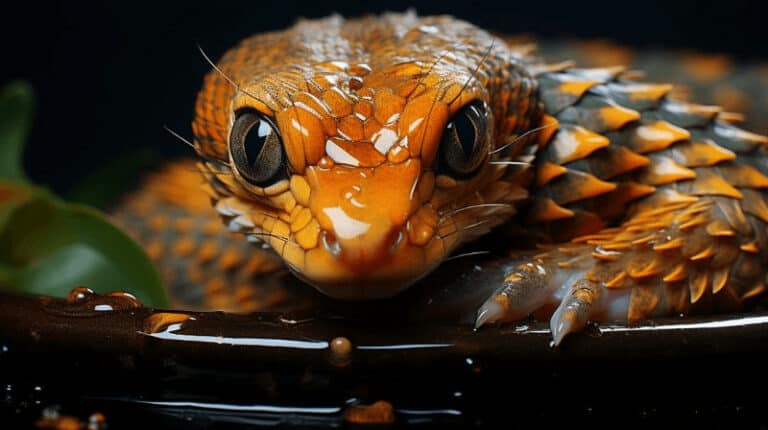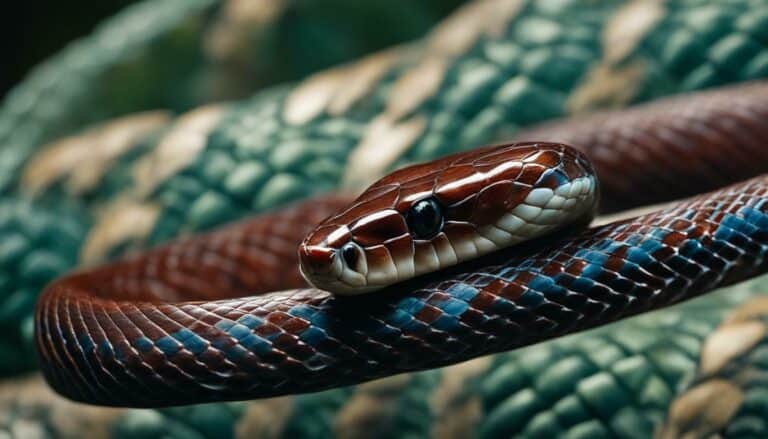How Do Snakes Get Water?
Do you ever stop and marvel at the remarkable ways snakes quench their thirst in their unique environments? From slithering through the grass to basking in the sun, these fascinating creatures have devised ingenious methods to stay hydrated.
In this article, we will delve into the world of snakes, uncovering the secrets behind their hydration strategies. Prepare to be amazed as we explore the various ways snakes drink water and the vital role hydration plays in their overall well-being.
Get ready to dive into this captivating world of snakes and discover the wonders of their water-drinking techniques.
Key Takeaways
- Snakes can drink from standing water by dipping their head into the pool and slowly chugging it.
- Some snakes have specialized scales to collect water droplets to drink off their body drop by drop.
- Arboreal snakes and those in arid places rely on rainwater or mist for water intake.
- The rain chamber at the zoo helps prevent dehydration and related health issues in snakes by providing them with a longer soak and adequate hydration.
Drinking From Standing Water
To drink from standing water, snakes like you can dip your head into the pool and slowly chug the water.
However, when it comes to hydration, rainwater and mist have significant benefits for snake health.
Rainwater is a natural source of hydration for arboreal snakes and those living in arid regions. These snakes rely on rain to replenish their water intake.
Additionally, misting is crucial for snake health as it helps to prevent dehydration. Misting provides a fine mist of water that snakes can drink from their skin or capture as droplets on specialized scales.
This method ensures that snakes receive adequate hydration and promotes their overall well-being.
While drinking from standing water is possible, rainwater and misting are essential for maintaining snake health and vitality.
Relying on Rainwater or Mist
Relying on rainwater or mist is a crucial survival strategy for snakes in arid environments or those that live in the treetops. In these conditions, access to standing water may be limited, making rainwater and mist their primary source of hydration.
Snakes have developed unique adaptations, such as specialized scales or body structures, to collect and drink water droplets efficiently.
Rain Vs. Mist: Which Is Better
When it comes to providing hydration for snakes, you may be wondering which is better: rain or mist. Both rain and mist have their advantages and disadvantages when it comes to keeping snakes hydrated. Here are four points to consider:
Rain:
- Advantages: Rain provides natural and direct hydration for snakes in their natural habitats. It allows snakes to drink water droplets off leaves or other surfaces.
- Disadvantages: Rain can be unpredictable and intermittent, making it difficult to ensure consistent hydration for captive snakes. It may also cause flooding in the enclosure if not properly managed.
Mist:
- Advantages: Mist can mimic the natural environment of arboreal snakes and those in arid places. It provides a continuous source of moisture for snakes to drink and can help maintain humidity levels in the enclosure.
- Disadvantages: Mist may not be as effective for snakes that rely on drinking water directly from standing sources. It may also require additional equipment to create and maintain the mist.
Understanding the effects of hydration on snake behavior is crucial for their overall well-being. Both rain and mist can play a role in ensuring snakes receive adequate hydration, but it’s important to consider the specific needs of each snake species and provide a suitable method accordingly.
Adaptations for Water Collection
You can observe how snakes have adapted to collect water through specialized scales and a unique drinking mechanism.
Snakes, especially arboreal ones and those in arid environments, rely on rainwater or mist for hydration. Some snakes have specialized scales that allow them to collect water droplets, which they then drink off their body drop by drop. Other snakes have scales that direct water towards their mouths.
These adaptations are essential for their survival in environments where water is scarce. By utilizing rainwater collection and their unique drinking mechanism, snakes are able to maintain their hydration levels and prevent dehydration.
This is just one example of the incredible adaptations that snakes have developed to thrive in their diverse habitats.
Specialized Scales for Water Collection
Snakes have specialized scales that collect water droplets for you to drink off your body drop by drop. These scales are a remarkable adaptation that allows snakes to obtain water in arid environments where standing water is scarce.
Here are four key points about snakes’ specialized scales for water collection:
-
Scales with hydrophobic properties: Some snake species have scales that repel water, causing water droplets to bead up on their skin. This allows the snake to easily collect and drink the water droplets as they roll off their body.
-
Scales that direct water towards the mouth: Other snakes have scales that are aligned in a way that directs water towards their mouth. This helps them to efficiently capture and drink water from rain or mist.
-
Benefits of misting: Snakes, especially arboreal species, rely on rainwater or mist for their water intake. Misting provides them with the necessary hydration and helps prevent dehydration, which can lead to health issues.
-
Natural behavior encouragement: In zoo settings, the Herps and Aquatics team often employs misting techniques to encourage natural behaviors in snakes. This includes using a rain chamber, a plastic container with a PVC pipe system that rains water over the snake, mimicking the natural rainforest environment.
Understanding and supporting these unique adaptations and behaviors ensure the well-being and freedom of snakes in captivity.
Scales Directing Water Towards Their Mouths
To drink water, you can thank the scales on some snakes that are aligned in a way that directs water towards their mouth. These specialized scales play a crucial role in meeting the hydration needs of snakes.
When water droplets come into contact with these scales, they’re collected and directed towards the snake’s mouth. This unique adaptation allows snakes to efficiently obtain water from various sources, such as rain or dew.
Snakes rely on adequate hydration for their overall health and well-being. Dehydration can lead to issues with shedding their skin and defecation, as well as more serious internal problems.
Understanding the importance of hydration, snake experts in places like the zoo ensure that snakes receive proper access to water through techniques like misting and providing rain chambers. By catering to the hydration needs of snakes, we can ensure their freedom from dehydration-related health issues.
Dependence on Rain or Mist for Water Intake
Now let’s explore the fascinating topic of snakes’ dependence on rain or mist for water intake.
Snakes, especially arboreal species and those living in arid environments, rely heavily on rainwater or mist to fulfill their hydration needs. Here are some key points to consider:
-
Rainwater vs. Mist: Both rainwater and mist offer advantages and disadvantages for snakes’ water intake. Rainwater provides larger quantities of water, while mist offers a consistent and gradual source. However, mist can evaporate quickly, reducing the amount of water available.
-
Pros and Cons: Collecting rainwater allows snakes to replenish their water supply efficiently. It’s a natural and abundant resource. On the other hand, mist is beneficial because it mimics the conditions snakes would encounter in their natural habitats, promoting their natural behaviors.
-
Strategies for Collecting Rainwater: Snakes have developed various strategies to collect rainwater. Some species possess specialized scales that enable them to collect water droplets on their bodies, which they then drink off drop by drop. Other snakes have scales that direct water towards their mouths, facilitating their water intake.
-
Importance of Rain or Mist: Rain or mist is vital for snakes as it prevents dehydration and associated health issues. Adequate hydration is crucial for maintaining overall snake health, ensuring proper shedding of skin, and preventing kidney problems.
Understanding the dependence of snakes on rain or mist for water intake is essential in providing optimal care for these remarkable creatures. By implementing effective strategies for collecting rainwater and mist, we can help ensure the well-being and freedom of snakes in captivity.
Watering Snakes at the Zoo
You can observe the zoo’s snakes being watered through misting and a rain chamber to ensure they receive proper hydration.
The Herps and Aquatics team at the zoo recognizes the importance of providing naturalistic habitats and alternative hydration methods for the snakes in their care. Instead of relying solely on standard water dishes, the team encourages natural behaviors by misting the snakes.
Additionally, a rain chamber is used, primarily for emerald tree boas that require more hydration. The rain chamber is a plastic container with a PVC pipe system attached to the lid. Water is pumped through the pipes, creating a rain effect over the snake inside.
This method helps prevent dehydration and related health issues in snakes, ensuring they receive adequate hydration in a naturalistic setting.
Arboreal Snakes and Water Dishes
Arboreal snakes may choose not to use the water dishes provided at the zoo, preferring alternative methods for obtaining hydration. These snakes exhibit natural behaviors that can be better supported through alternative methods of providing hydration. Here are four alternative methods for hydrating arboreal snakes:
-
Misting: Arboreal snakes, such as emerald tree boas, can be misted with water to mimic rain in their natural habitat. This allows them to drink droplets of water from their skin and leaves.
-
Rain chamber: A rain chamber is a plastic container with a PVC pipe system attached to the lid. Water is pumped through the pipes, creating rain over the snake inside. This method provides a longer soak and helps prevent dehydration.
-
Water-rich environment: Creating a water-rich environment with live plants and foliage can provide additional opportunities for arboreal snakes to drink water droplets from leaves and surfaces.
-
Humidity control: Maintaining optimal humidity levels in the snake’s enclosure is crucial for their hydration. This can be achieved through the use of misters, foggers, and humidifiers.
Encouraging Natural Behaviors Through Misting
Encouraging natural behaviors through misting is a crucial aspect of snake care. By mimicking the natural environment of arboreal and arid snakes, misting provides them with the opportunity to drink water in a way that aligns with their instinctive behaviors.
Additionally, misting helps maintain proper hydration levels, preventing dehydration and related health issues.
Importance of Misting
Misting the snakes in the rain chamber helps maintain their hydration levels and prevents dehydration-related health issues. Here are four reasons why misting is important for snake health:
-
Mimicking the natural environment: Snakes in the wild rely on rain and mist for their water intake. By misting them in the rain chamber, we recreate their natural habitat and provide them with the hydration they need.
-
Preventing dehydration: Dehydrated snakes can experience issues with defecation and shedding their skin. Prolonged dehydration can even lead to kidney problems and other internal complications. Misting ensures that snakes receive adequate hydration, keeping them healthy and hydrated.
-
Supporting natural behaviors: Arboreal snakes, especially, rely on rainwater and mist for their water intake. By misting them, we encourage their natural behaviors and help them thrive in captivity.
-
Customized hydration: Different snake species have varying hydration needs. The rain chamber allows us to tailor the misting duration to meet the specific requirements of each snake, ensuring they receive the right amount of hydration for optimal health.
Mimicking Natural Environment
To recreate the natural environment for snakes, you can use misting in the rain chamber to provide them with the hydration they need. Mimicking the natural habitat of snakes is crucial for their overall well-being and health.
By using a rain chamber, you can simulate the conditions that snakes would encounter in their natural environment, such as rainfall or mist. This helps to ensure that they receive adequate hydration, as many snake species rely on rain or mist for their water intake.
The rain chamber is a plastic container with a PVC pipe system attached to the lid, allowing water to be pumped through the pipes and rain over the snake inside.
Benefits for Snake Health
Now let’s explore the benefits of hydration and the different water sources for snakes.
Ensuring proper hydration is essential for maintaining snake health. Here are four significant benefits of hydration for snakes:
-
Improved digestion: Adequate hydration helps snakes with their digestive process, promoting smooth digestion and preventing issues with defecation.
-
Healthy shedding: Hydration plays a crucial role in the shedding process for snakes. Sufficient moisture allows their old skin to slough off easily, preventing complications and ensuring a healthy new layer.
-
Kidney function: Dehydration can lead to kidney issues in snakes, affecting their overall health. Proper hydration helps maintain optimal kidney function and prevents related internal problems.
-
Overall well-being: Hydration is vital for the overall well-being of snakes. It helps keep their bodies functioning properly, maintains their energy levels, and supports their immune system.
Snakes rely on various water sources, including standing water, rainwater, mist, and water droplets collected on their scales. Providing access to these water sources, such as through natural behaviors like misting or using a rain chamber, ensures snakes receive the hydration they need to thrive.
The Rain Chamber for Hydration
The rain chamber provides a controlled environment for snakes to receive the necessary hydration. This innovative tool benefits snake health by preventing dehydration and related issues.
The chamber is a plastic container with a PVC pipe system attached to the lid. It features a PVC perch for the snake to sit on while water is pumped through the pipes, causing it to rain over the snake inside.
Different snake species have varying hydration needs, and the rain chamber allows for customized hydration timeframes. Dehydration in snakes can lead to problems with defecation, shedding, and even internal organ issues.
Preventing Dehydration and Health Issues
To prevent dehydration and potential health issues in snakes, it’s crucial to ensure they have access to an adequate water source and maintain proper hydration levels. Dehydration can lead to difficulties with defecation and shedding, as well as more serious internal problems like kidney issues.
Dehydration in Snakes
Dehydration in snakes can lead to issues with defecation and shedding their skin. To prevent dehydration in captivity and promote natural behaviors, it’s crucial to design their habitat appropriately.
Here are the four essential factors to consider:
-
Water sources: Provide snakes with access to fresh water at all times. Use water dishes or misting systems to mimic natural conditions.
-
Humidity levels: Maintain proper humidity levels in the snake’s enclosure. This can be achieved by using misters or incorporating live plants that release moisture.
-
Temperature gradients: Snakes need access to different temperature zones within their habitat. This allows them to regulate their body temperature and prevent dehydration.
-
Environmental enrichment: Create a stimulating and enriching environment that encourages natural behaviors. Include hiding spots, climbing structures, and opportunities for the snake to explore and interact with its surroundings.
Health Issues From Dehydration
Ensuring adequate hydration for your captive snake is crucial to prevent health issues related to dehydration. Dehydration can have a significant impact on snake behavior and overall well-being. When snakes don’t receive enough water, they may experience difficulties with shedding their skin and have problems with defecation. Prolonged dehydration can even lead to kidney issues and other internal problems.
To prevent dehydration in snakes, it’s important to provide them with proper hydration methods. This can include using water dishes for drinking, misting or providing rainwater for arboreal snakes, and using specialized scales or rain chambers to collect water droplets.
Preventing Dehydration in Snakes
To prevent dehydration in snakes, it’s essential to provide them with proper hydration. Ensuring that your snake has access to water is crucial for its overall health and well-being. Here are four important benefits of hydration for snake health:
-
Improved digestion: Hydration helps snakes maintain healthy digestion and prevents issues with defecation. Adequate water intake ensures that waste is properly eliminated from the body.
-
Healthy shedding: Snakes require proper hydration to shed their skin successfully. Without enough water, the shedding process can become difficult and may lead to complications such as retained skin or skin infections.
-
Kidney function: Hydration plays a vital role in maintaining proper kidney function in snakes. Dehydration can lead to kidney problems and other internal issues that can significantly impact the snake’s health and longevity.
-
Overall well-being: Hydrated snakes are generally healthier and more active. Proper hydration helps maintain their energy levels, keeps them hydrated, and contributes to their overall well-being.
Importance of Hydration for Snake Health
Hydration is crucial for maintaining your snake’s health and preventing related issues. Ensuring that your snake is properly hydrated has numerous benefits. It helps with digestion, as dehydration can lead to difficulties in defecation. Adequate hydration also aids in the shedding process, preventing issues such as incomplete shedding or retained eye caps.
To hydrate your snake, there are various techniques you can employ. Providing a water dish is a common method, but keep in mind that arboreal snakes may prefer to drink from rainwater or mist. Some snakes have specialized scales that allow them to collect water droplets, while others have scales that direct water towards their mouths.
It’s important to understand the specific hydration needs of your snake species to ensure they receive the proper amount of water.
Animal Care and Unique Needs
Now let’s delve into the fascinating world of animal care and the unique needs of snakes. As a snake owner, it’s important to provide the best possible care for your scaly companion. Here are four essential aspects to consider when it comes to the well-being of your snake:
Enclosure Requirements:
- Snakes require an enclosure that mimics their natural habitat.
- The enclosure should be spacious enough for the snake to move around comfortably.
- It should have appropriate temperature and humidity levels, as these factors are crucial for the snake’s health.
- The enclosure should also have secure lids or doors to prevent any escape attempts.
Enrichment Activities:
- Snakes are curious creatures that benefit from mental and physical stimulation.
- Provide hiding spots, climbing branches, and objects to explore in their enclosure.
- Engage your snake with toys and puzzles designed for their species.
- Regular handling and supervised exploration outside of the enclosure can also provide enrichment.
By following these enclosure requirements and providing enrichment activities, you can ensure that your snake thrives in a nurturing and stimulating environment.
Snake Drinking Mechanism and Anatomy
You may be curious about how snakes actually drink, and it’s interesting to know that they’ve a unique sponge-like mechanism in their mouth. This mechanism allows them to effectively consume water.
Unlike other animals, snakes don’t use their tongues or mouths to scoop up water. Instead, they keep their heads still and rely on the sponge-like structure in their mouth to do the work of sucking in water. This behavior is consistent across most snake species.
When it comes to snake reproduction, mating behaviors can vary among different species. Male snakes use various methods to attract female snakes, while females may release pheromones to attract males. Once mating occurs, female snakes may lay eggs or give birth to live young, depending on the species.
Frequently Asked Questions
How Do Snakes Drink Water in the Wild?
Snakes drink water in the wild by using a sponge-like mechanism in their mouth. They keep their heads still while the structure sucks in water. They don’t use their tongues or mouths to scoop water.
What Are the Different Ways That Snakes Obtain Water in Their Natural Habitats?
Snakes, like you, have diverse ways of finding water in their natural habitats. They rely on rain, mist, or specialized scales to collect water droplets. It’s fascinating how they adapt to different environments for their hydration needs.
Do All Snake Species Have Specialized Scales for Collecting Water Droplets?
All snake species do not have specialized scales for collecting water droplets. However, snake hydration is crucial for their health and water conservation. Different snake species have varying hydration needs.
How Do Snakes With Scales That Direct Water Towards Their Mouths Use This Adaptation to Drink?
Snakes with scales that direct water towards their mouths use this adaptation by positioning themselves under rain or mist and letting the water flow along their scales into their mouths, ensuring a steady supply of hydration.
Are There Any Snake Species That Do Not Rely on Rain or Mist for Water Intake?
Some snake species, such as those in arid environments, have adapted to rely on alternative water sources like dew and moisture in their prey. They have evolved strategies to obtain water without depending solely on rain or mist.
Conclusion
In conclusion, snakes have fascinating methods of obtaining water to ensure their hydration and overall health.
For example, at the zoo, a case study revealed that a snake named Rex, who’d access to a water dish, showed improved skin condition and overall vitality compared to snakes without regular access to water.
This highlights the importance of providing proper hydration for snakes in captivity. Understanding and implementing these watering practices are crucial for the well-being of these remarkable reptiles.
